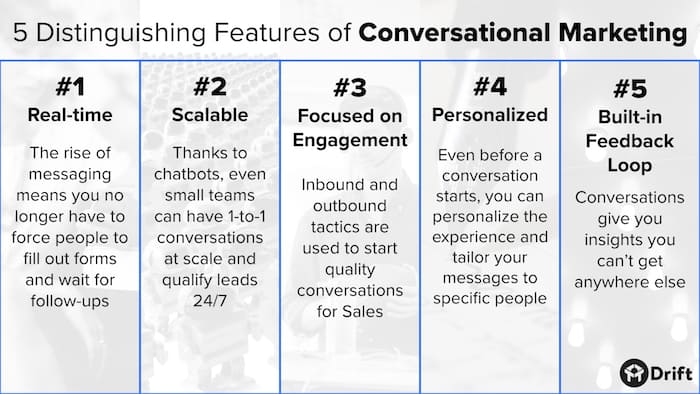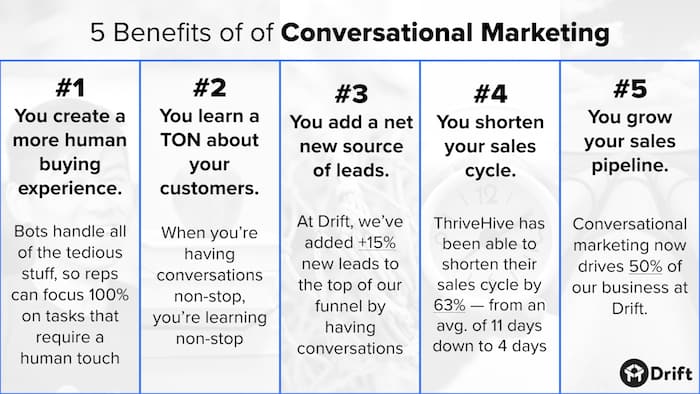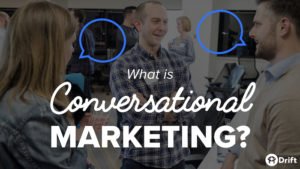
Conversational Marketing Definition
Conversational marketing or conversation marketing is a one-to-one approach to marketing that companies use to shorten their sales cycle, learn about their customers, and create a more human buying experience.
Unlike traditional marketing, conversational marketing uses targeted, real-time messaging and intelligent chatbots instead of lead capture forms — that way leads never have to wait for follow-ups, and can engage with your business when it’s convenient for them (like when they’re live on your website).
Of course, conversations with potential customers don’t just happen on your website, which is why conversational marketing is bigger than any single channel or platform. Combining inbound and outbound tactics, conversational marketing is all about starting a dialogue with the people who can benefit from what you’re offering, whether that’s via a face-to-face meeting, or a phone call, or an email exchange.
Regardless of the medium, with conversational marketing you’re not just blasting your messaging outward, or forcing people to take an action: You’re answering people’s questions, and listening to their feedback, and then uncovering new ways to help them.
In other words, you’re having an actual conversation.
Conversational marketing is the way your customers want to buy. Learn how Drift makes it possible here.
The Customers Have Spoken.
It’s time for a reality check:
After talking to thousands of customers, what we’ve heard loud and clear (and maybe you’ve felt this, too) is that something is broken with the way we market and sell.
Over the past several years, we’ve become obsessed with tracking and measuring every metric imaginable: hits, clicks, emails, dials, and so on.
We’ve become so focused on things like A/B testing, retargeting, email blasts, robocalls, form fills, marketing-qualified leads (MQLs), and sales-qualified leads (SQLs), that we’ve lost track of what really matters.
At some point, being data-driven started being more important than being customer-driven.
As a result, the buying experience most companies provide has become cold and impersonal. For many marketing and sales teams, their leads have become faceless entities that exist only inside of spreadsheets — they aren’t treated like actual people.
Not only is it a terrible experience for potential customers, it’s also bad for business.
There’s a reason why only 43% of people answer cold calls, and the average email open rate is about 20%, and the average landing page conversion rate is just 2.35% …
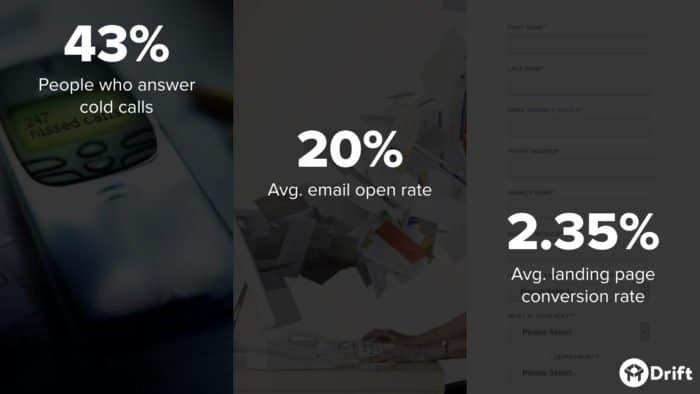
The way we’ve been doing marketing and sales is broken.
The good news? You already know how to fix it, because the solution has always been there:
We need to make business personal again.
So that’s exactly what we’re doing, and thousands of businesses are doing it with us. And the way we’re doing it is by putting one-to-one communication and dialogue back at the center of everything.
We’re replacing traditional marketing with conversational marketing.
Keep reading to learn more about what conversational marketing is, what kind of results it’s been driving for businesses, and how you can implement conversational marketing at your business.
[email_form paragraph=”Join 20,000+ marketers who read our conversational marketing content every week on the Drift Blog.” bold_paragraph=”Interested in Conversational Marketing?” confirmation=”Awesome, welcome to the Drift community! We’ll email you.”]
Table of Contents
1. 5 Distinguishing Best Practices of Conversational Marketing
1) Real-time
Instead of forcing people to fill out static lead forms and wait for follow-ups (that might never come), conversational marketing focuses on engaging people in real-time, both with human-to-human conversations and human-to-chatbot conversations.
Thanks to the rise of intelligent chatbots, anytime a potential customer asks a question, your company can now be there to provide a real-time response — 24/7, 365. Same goes for if a potential customer wants to a book a demo with a sales rep. A chatbot can take care of scheduling that anytime, day or night.
Remember: it’s not about replacing human-to-human interactions (those are definitely still the best kind!), it’s about making sure your potential customers get their questions answered as quickly as possible. Because ultimately, if you can’t provide an answer to someone’s question right away, that person is going to go ask someone else — possibly a competitor.
That’s just the nature of the on-demand, real-time world that we live in these days, where everything seems to be one click away. Conversational marketing was born out of this real-time world, and is the only marketing methodology that’s adapted to it.
2) Scalable
Marketing and sales teams have known about the power of one-to-one conversations for decades, but there’s always been one lingering problem:
“Having one-to-one conversations doesn’t scale.”
That’s why teams have been locking up conversations behind “Contact Us” forms. Because marketers and salespeople just don’t have the bandwidth to talk to every lead who drops by the site…right?
Back before the rise of real-time messaging and chatbots, scaling conversations was a hard nut to crack. Because in order to have 100 one-to-one conversations with leads simultaneously, you’d need to have 100 employees dialing and smiling.
With the rise of messaging, which has been popular with support teams for years, a single employee gained the ability to manage multiple, concurrent one-to-one conversations.
And now with the rise of chatbots, the ability to scale conversations has reached unprecedented levels — which is why conversational marketing has been taking off.
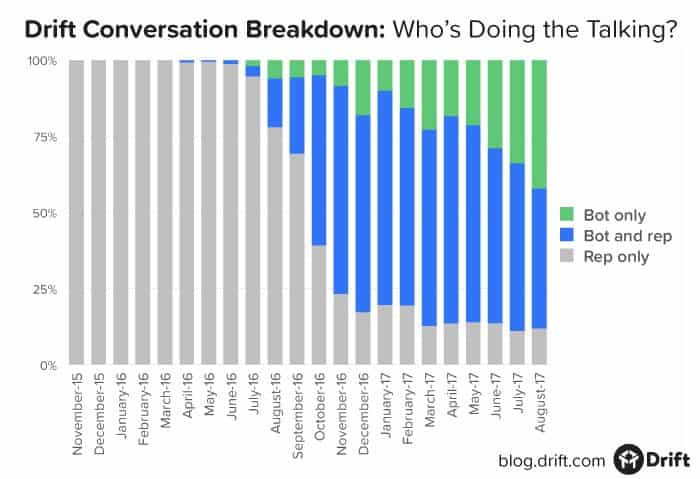
A single marketer can now set up a chatbot that automatically greets hundreds or thousands of visitors and asks them qualifying questions. That bot can then route qualified leads to specific sales reps (based on territory/ownership in Salesforce) or help those leads book demos on a rep’s calendar. It’s like you’re opening up a fastlane for your best leads.
3) Focused on Engagement
Marketing teams have traditionally been measured on how many leads they capture via lead capture forms, or how many MQLs they generate.
With conversational marketing, the focus shifts from passively collecting contact info, to actively engaging people in conversation. Instead of MQLs, you’re looking for CQLs: conversation-qualified leads. People you actually talk to who tell you, “Hey, I’m interested in your product and want to learn more.”
Of course, inbound leads are always going to be an important part of that equation. And by setting up welcome messages and targeting your messages to specific visitors, you can make sure no leads are slipping through the cracks.
But conversational marketing can include outbound tactics, too. Wherever there’s a conversation with a potential customer to be had, you should be having it. So that’s not just limited to your website.
With email, for example, you can proactively reach out to a lead and get the conversation started. The difference is that instead of blasting that person with a generic message, you’re crafting something personalized (more on that next) and — by including a link that triggers a chatbot — you’re giving them the opportunity to start a real-time conversation if they want to.
4) Personalized
With conversational marketing, every interaction you have with a lead has context, because your team can always reference previous conversations.
But even when you’re talking to a lead for the very first time, you can add a personalized touch.
At the most basic level, you can customize the conversations you’re having on different pages of your site. For example, when a lead is on your pricing page, you can have a welcome message automatically appear that says, “Hey, this is [your name], I see that you’re checking out our pricing page. Let me know if you have any questions.”
But that’s really just the tip of the iceberg.
With enriched data, you can tailor messages based on specific information about companies (a.k.a. firmographics) as well as the specific tools they’re using (a.k.a. technographics).
You can even surface the name of the company a visitor works at via IP address matching and insert it into a message. Alternatively, once you learn the company a lead works at, you may choose to reference some of their competitors in your message, or other companies in their industry. The goal is to grab their attention and to convince them that you’re worth having a conversation with.
5) Built-in Feedback Loop
Unfortunately, a lot of companies still take a Mad Men approach to marketing and sales:
They sit in closed rooms, cut off from customers, and dream up ideas for how they can attract new customers. It’s an entirely company-driven process, which puts more value on the ideas of internal stakeholders than the feedback of actual customers (or potential customers).
With conversational marketing, the customer feedback loop is built in. Because with every interaction, you’re giving leads and customers the opportunity to share their opinions.
Most people think “selling” is the same as “talking”. But the most effective salespeople know that listening is the most important part of their job. — Roy Bartell
Feedback is like a battery that powers your marketing and sales decisions. It has positive and negative sides, but you need both positive and negative feedback in order to figure out what’s working and what isn’t.
(Pssst. Need help figuring out what to do with customer feedback after you collect it? Check out this customer feedback framework our CEO created.)
2. The History of Conversational Marketing
Centuries before the terms “conversational marketing” or “conversation marketing” started being used, people were already practicing the concept. That’s because conversations have been integral to marketing and sales since… the beginning of marketing and sales.
Before the internet, before the telephone, before the printing press, one-to-one conversations were how people marketed and sold their products. And it’s still how a lot of corner stores, mom and pop shops, and other small businesses market and sell today.
But over time, companies began to distance themselves from their customers. As explained in the 2000 book, The Cluetrain Manifesto, the rise of broadcast media and advertising broke down those personal connections and one-to-one conversations that had once driven marketing and sales. Here’s a quote:
For thousands of years, we knew exactly what markets were: conversations between people who sought out others who shared the same interests. Buyers had as much to say as sellers. They spoke directly to each other without the filter of media, the artifice of positioning statements, the arrogance of advertising, or the shading of public relations.
The good news is that there’s nothing preventing you from speaking directly with your customers. And that’s exactly what conversational marketing aims to do.
One of the first marketers to write about “conversational marketing” a.k.a. “conversation marketing” was Joseph Jaffe — author of the 2007 book Join the Conversation. He sees the future of marketing as a return to having “authentic conversations” with customers.
The central message is simple: There are literally millions of alive, flawed, human, passionate, influential and authentic conversations going on around you right now: isn’t it time you joined in?…Through the power of community, dialogue and partnership, marketing can be a conversation; a welcome guest in the homes, experiences and lives of our consumers.
Today, nobody thinks of marketing as a “welcome guest.” And that’s a result of the impersonal approach we’ve been taking for so long — an approach that values measurement and tracking and form-fills over creating an incredible buying experience.
Conversational marketing is how we fix things. It’s how we get back to basics and make business personal again.
50,000+ businesses are using Drift to convert their traffic into qualified leads while they’re sleeping. Learn more about us here.
3. Capture, Qualify, Connect: The Conversational Marketing Strategy & Methodology
Look, we get it: Conversational marketing can sound great in theory, but when it comes to actually doing it, the details can become fuzzy.
That’s why we created a methodology that shows you — step by step — how to use conversational marketing to turn visitors into leads, lead into opportunities, and opportunities into customers.
We call it “Capture, Qualify, Connect.”
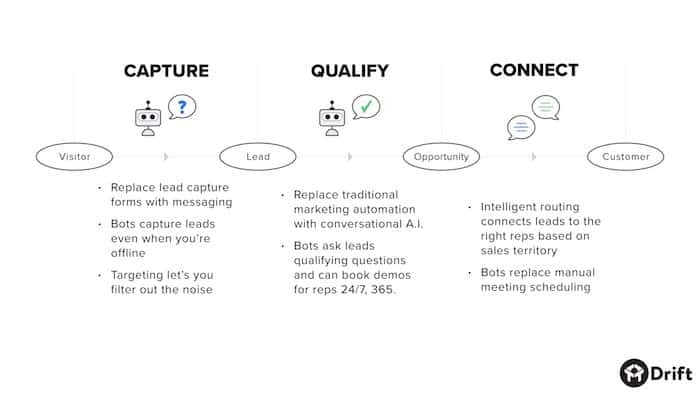
Step 1: Capture
For the past decade, marketers have been pouring tons of time and energy into SEO and driving more traffic to their sites…only to make everyone fill out the same-old lead capture form.
With conversational marketing, you replace the forms on your website with conversations. Specifically, you can use real-time messaging and/or an intelligent chatbot — both of which can be shown to specific visitors (or displayed on specific pages) based on the criteria you set.
If you’re just starting out, we recommend letting your current website traffic determine where you surface your messaging widget or chatbot.
Not getting much traffic? Put them everywhere — You want as many conversations as possible. Lots of traffic? Target your high-intent pages only, like your pricing page — That way you can filter out some of the visitors who aren’t serious about buying.
And, as I mentioned earlier, with enriched data you can even personalize your messages with a company’s name or other information.

When a conversation starts, any contact info a lead enters (e.g. email, phone number) can be captured automatically. This is true whether it’s a human doing the talking or one of your chatbots.
Best of all, once contact info gets captured, the conversation doesn’t have to stop — a lead can continue on through your sales funnel at lightning speed, since all of their questions can be answered in real-time.
Step 2: Qualify
According to research from InsideSales.com & HBR, if you want to increase your odds of qualifying a lead, you need to respond within five minutes of them reaching out.
Because if you wait 10 minutes, guess what? You’ll be looking at a 400% decrease in your odds of qualifying that lead.
Unfortunately, our lead management survey of 433 B2B companies found that just 7% responded within five minutes. Meanwhile, 55% took 5+ days to respond or never responded at all.
Using conversational marketing, you can always respond within that five-minute window because you’ll always have a chatbot online, 24/7, to respond to new leads in real-time. What’s more, the chatbot can qualify those leads for you — even if your BDRs or sales reps are all asleep.
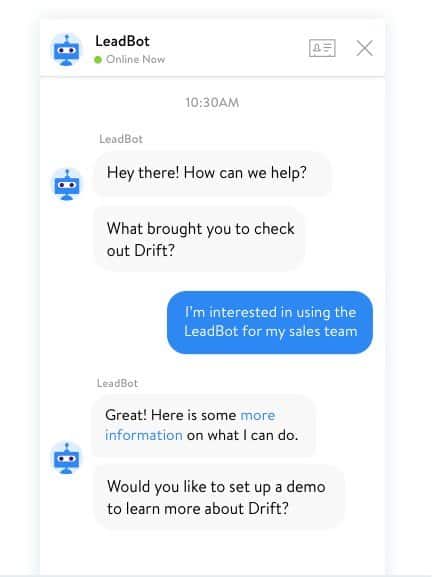
All you need to do is take the questions your team is already asking and turn them into a script for the bot. Here’s a popular script framework we’ve seen companies using:
- Question 1: What brought you here?
- Question 2: Who are you? / What company do you represent?
- Question 3: How are you thinking about using our product?
- CTA: Book a demo. / Talk to a human.
Of course, not everyone who goes through this qualifying script will make it to the CTA. You get to control what the disqualifying criteria are, so when a chatbot hears a disqualifying answer, you can have it say something like, “Sorry, we don’t think our product is a good fit for you at the moment.”
The leads who do qualify, meanwhile, can be routed automatically to the right sales rep (or the right sales rep’s calendar), which leads us the final stage of the Capture, Qualify, Connect methodology…
Step 3: Connect
So far, we’ve seen that chatbots have been able to do a lot of the legwork when it comes to capturing and qualifying leads. But for the final stage, it’s all about having sales reps connect with qualified leads human-to-human (no offense, bots).
Thanks to intelligent routing, leads can always get connected to the right reps automatically based on sales territory. And if you have multiple reps working in the same territory, leads can be assigned to reps on a rotating basis.
For leads who might need a little nudge coming back to your site, a rep can now send an email that includes a link that triggers a live conversation. If the rep who sent the email is available, perfect — they can hop in and qualify that lead.
But if the rep isn’t available at that exact moment, it isn’t a huge deal. Chatbots will always have your back, and can hop in and continue the conversation for you.
When it comes to setting up a time for a demo, a lead can check the available times on a rep’s calendar with the click of a button. And then a bot can take care of sending meeting invites to both sides.
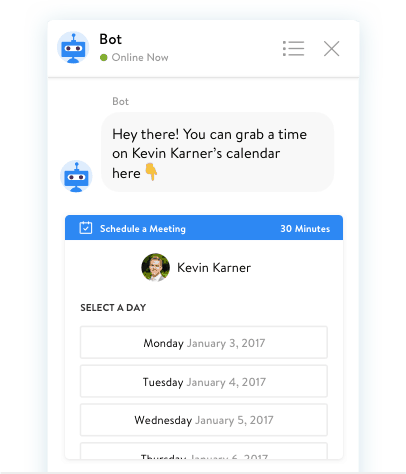
The end result is that people get to spend more time talking about the important stuff, and less time dealing with tedious tasks.
4. The Benefits of Adopting Conversational Marketing
You create a more human buying experience.
With the old approach, your website was like an empty store, where shoppers could walk in but there was no one there to greet them. No one said hello. Instead, anyone who was interested in buying something had to write down their contact info and wait for a follow-up.
In contrast, with conversational marketing, you have friendly salespeople out in the aisles who let all the shoppers know that they’re available to help and answer questions.
With conversational marketing, you actually say “hello” to the people who take the time to visit your site and learn more about your product. And you allow those people to start conversations with you when it’s convenient for them.
True, chatbots are helping to make conversational marketing possible, but they’re not replacing human-to-human conversations outright. Instead, they’re helping buyers have the right conversations with the right people at the right times (when it’s convenient for them, not your sales team). So while it might sound counterintuitive, bots are actually helping marketing and sales teams deliver a more human experience.
You learn a TON about your customers.
Lead capture forms are good at collecting contact info, but what they’re not good at is providing context… Why did that person decide to come by the site in the first place? What’s their biggest pain point? What product feature are they most excited about?
Sure, you could ask any question you want with a form, but it will never deliver the same insights you can get from having an actual, one-to-one conversation.
Case in point: Rapidminer CMO Tom Wentworth was interviewed for a Harvard Business Review article about how A.I. is poised to streamline marketing and sales. Here’s an excerpt where he explains why conversations are such valuable opportunities for learning:
Every day, Wentworth reviews conversations people have had with Drift. “I’ve learned things about my visitors that no other analytics system would show,” said Wentworth. “We’ve learned about new use cases, and we’ve learned about product problems.” This is the strength of an AI agent that can elicit information like a person, rather than an analytics tool that simply finds patterns in the data it collects, like a machine.
You add a net new source of leads
At Drift, we’ve added 15% more leads to the top of our funnel using conversational marketing. Those are leads we would’ve missed out on if we had only been using the traditional, form-and-follow-up approach.
And we’re not the only ones. Year-to-date, RapidMIner has generated more than 4,000 leads using our conversational approach.
You shorten your sales cycle.
The leads we generate via conversational marketing (CQLs) close more quickly than traditional leads. On average, it takes just three days from an initial conversation with a lead to the time we’re delivering a demo to that lead.
ThriveHive, meanwhile, has seen their conversational marketing leads close at 2x the rate of leads from other sources. The sales cycle for those leads lasts four days on average — compared to 11 days on average for leads from other sources. Overall, the sales cycle for leads sourced from conversations is 63% shorter than ThriveHive’s typical sales cycle.
You grow your sales pipeline.
While they only represent 15% of the leads we’ve generated, leads from conversational marketing drive 50% of our business at Drift.
That’s half our business being driven by conversations. And we’re not the only ones who’ve seen the effect conversations can have on sales pipeline.
In their first two months of using conversational marketing, the value of TreeRing’s opportunity pipeline has increased by 10%.
Meanwhile, conversations have influenced 25% of RapidMiner’s open sales pipeline — worth more than $1 million.
5. Final Thought: How to Make the Switch to Conversational Marketing
It might seem like a massive undertaking to make the switch to conversational marketing, especially if you already have a well-oiled marketing machine up and running.
But here’s the thing: You don’t need to take an all or nothing approach.
While we made the decision at Drift to remove gated content replace all of our lead capture forms, that doesn’t mean you have to. In order to get started with conversational marketing, you keep everything exactly the same, and simply add conversational marketing to the mix.
You can think of it as a “second net,” a second channel that can capture and qualify leads for you — only this one’s real-time, and is powered by conversations.
Just take a look at how Perfecto Mobile incorporated conversational marketing on their website:
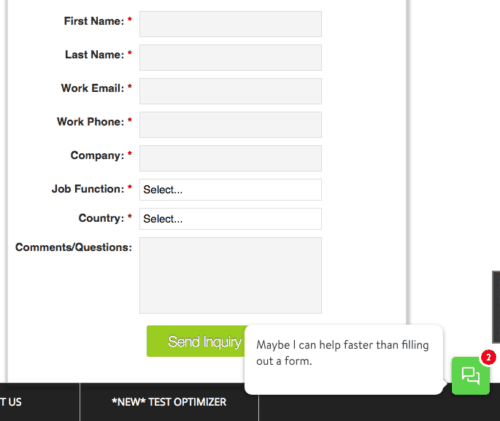
To quote Perfecto Mobile’s CMO: “If leads are able to initiate a conversation — so skip the form — and have a conversation in real-time, we’re seeing that move very quickly.”
By giving people the option to skip the form and have a one-to-one conversation, you’re helping to make personal again.
And that’s what conversational marketing is all about.




